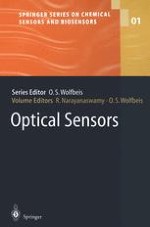
2004 | OriginalPaper | Buchkapitel
Optical Technology until the Year 2000: An Historical Overview
verfasst von : Otto S. Wolfbeis
Erschienen in: Optical Sensors
Verlag: Springer Berlin Heidelberg
Enthalten in: Professional Book Archive
Aktivieren Sie unsere intelligente Suche, um passende Fachinhalte oder Patente zu finden.
Wählen Sie Textabschnitte aus um mit Künstlicher Intelligenz passenden Patente zu finden. powered by
Markieren Sie Textabschnitte, um KI-gestützt weitere passende Inhalte zu finden. powered by
This chapter reviews advances in the area of optical sensor technology using indicator probes and labels. It also presents an account of optical sensors based on the use of biomolecules and molecular receptors including molecular imprints. One may wonder why such progress has been made in the past 20 years. In the author’s opinion, this is due to several factors. These include the following: (a)New light sources have become available, including light-emitting diodes and diode lasers with their low power consumption and small size, both now spanning the entire visible range (LEDs even available with emission peaks at 370 nm);(b)new photodiodes and CCDs have become available with hitherto unseen sensitivity for visible and near-infrared light;(c)the advent of fiber optics and of integrated waveguide optics with excellent transmission that extends far into the near infrared;(d)wave guides have become available that also transmit mid-infrared and infrared light;(e)fast detectors, oscilloscopes and log-in amplifiers are now available at low cost; these allow sensitive and highly time-resolved measurements;(f)new detection schemes including surface plasmon resonance, evanescent wave sensing have found their way into sensor technology;(g)fluorescence spectroscopies (which are so useful for sensing purposes) have become particularly widespread and include the measurement of fluorescence (or phosphorescence) intensity, decay time, energy transfer, quenching efficiency, polarization, and allow gated measurements that can eliminate interfering background luminescence;(h)new biomolecular receptors (synthetic, made from plastic, or genetically engineered) are available that may be used for sensing purposes;(i)substantial progress has been made in nucleic acid chemistry and protein chemistry, including the immobilization of these biomolecules;(j)progress in polymer chemistry, which is particularly significant since polymer chemistry plays a major role in optical sensor technology; this is particularly true for sensor matrices, biocompatible materials, and new materials including composite polymers (e.g. for molecular imprints), hydrogels, and sol-gels;(k)powerful data processors and data loggers have become available at affordable prices; finally,(l)it is believed that interdisciplinary teaching and interdisciplinary conferences like Europtrode have contributed to an improved understanding and interaction between scientists involved in optical sensor technology.